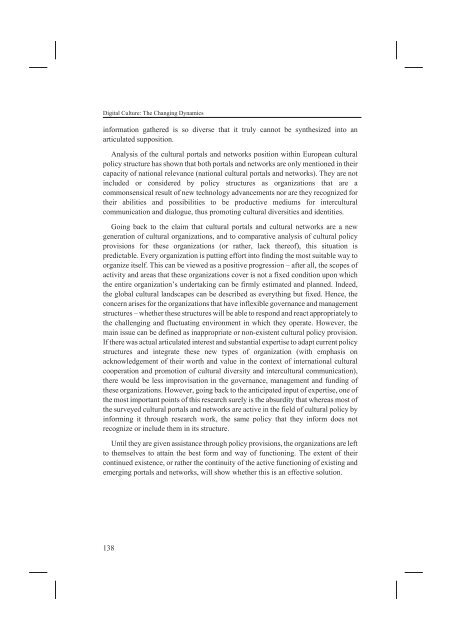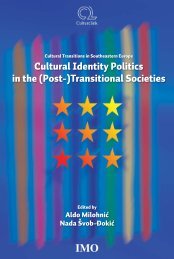D:\Documents and Settings\Ana\My Documents\Biserka-knjiga ...
D:\Documents and Settings\Ana\My Documents\Biserka-knjiga ...
D:\Documents and Settings\Ana\My Documents\Biserka-knjiga ...
You also want an ePaper? Increase the reach of your titles
YUMPU automatically turns print PDFs into web optimized ePapers that Google loves.
Digital Culture: The Changing Dynamics<br />
information gathered is so diverse that it truly cannot be synthesized into an<br />
articulated supposition.<br />
Analysis of the cultural portals <strong>and</strong> networks position within European cultural<br />
policy structure has shown that both portals <strong>and</strong> networks are only mentioned in their<br />
capacity of national relevance (national cultural portals <strong>and</strong> networks). They are not<br />
included or considered by policy structures as organizations that are a<br />
commonsensical result of new technology advancements nor are they recognized for<br />
their abilities <strong>and</strong> possibilities to be productive mediums for intercultural<br />
communication <strong>and</strong> dialogue, thus promoting cultural diversities <strong>and</strong> identities.<br />
Going back to the claim that cultural portals <strong>and</strong> cultural networks are a new<br />
generation of cultural organizations, <strong>and</strong> to comparative analysis of cultural policy<br />
provisions for these organizations (or rather, lack thereof), this situation is<br />
predictable. Every organization is putting effort into finding the most suitable way to<br />
organize itself. This can be viewed as a positive progression – after all, the scopes of<br />
activity <strong>and</strong> areas that these organizations cover is not a fixed condition upon which<br />
the entire organization’s undertaking can be firmly estimated <strong>and</strong> planned. Indeed,<br />
the global cultural l<strong>and</strong>scapes can be described as everything but fixed. Hence, the<br />
concern arises for the organizations that have inflexible governance <strong>and</strong> management<br />
structures – whether these structures will be able to respond <strong>and</strong> react appropriately to<br />
the challenging <strong>and</strong> fluctuating environment in which they operate. However, the<br />
main issue can be defined as inappropriate or non-existent cultural policy provision.<br />
If there was actual articulated interest <strong>and</strong> substantial expertise to adapt current policy<br />
structures <strong>and</strong> integrate these new types of organization (with emphasis on<br />
acknowledgement of their worth <strong>and</strong> value in the context of international cultural<br />
cooperation <strong>and</strong> promotion of cultural diversity <strong>and</strong> intercultural communication),<br />
there would be less improvisation in the governance, management <strong>and</strong> funding of<br />
these organizations. However, going back to the anticipated input of expertise, one of<br />
the most important points of this research surely is the absurdity that whereas most of<br />
the surveyed cultural portals <strong>and</strong> networks are active in the field of cultural policy by<br />
informing it through research work, the same policy that they inform does not<br />
recognize or include them in its structure.<br />
Until they are given assistance through policy provisions, the organizations are left<br />
to themselves to attain the best form <strong>and</strong> way of functioning. The extent of their<br />
continued existence, or rather the continuity of the active functioning of existing <strong>and</strong><br />
emerging portals <strong>and</strong> networks, will show whether this is an effective solution.<br />
138



